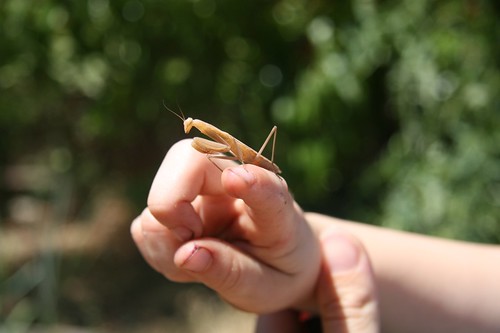
The other day while walking through the yard with my camera I glanced down at my shoulder and saw this little guy sitting on it. There he was sitting here, just along for a free ride, as I strolled along. Of course my little one wanted desperately to hold him. This hasn’t been the first time we’ve had a hitch hiking praying mantis. They are friendly little creatures and love to hop on for a free ride when they see that you’re walking through the garden. And they’re bad ass too. Read this description I got from Wikipedia:
Mantises are notable for their hunting abilities. They are exclusively predatory, and their diet usually consists of living insects, including flies and aphids; larger species have been known to prey on small lizards, frogs, birds, snakes, and even rodents. Most mantises are ambush predators, waiting for prey to stray too near. The mantis then lashes out at remarkable speed. Some ground and bark species, however, pursue their prey rather quickly. Prey are caught and held securely with grasping, spiked forelegs (“raptorial legs”); the first thoracic segment, the prothorax, is commonly elongated and flexibly articulated, allowing for greater range of movement of the front limbs while the remainder of the body remains more or less immobile. The articulation of the head is also remarkably flexible, permitting nearly 300 degrees of movement in some species, allowing for a great range of vision (their compound eyes have a large binocular field of vision) without having to move the remainder of the body.
Ellen asked me the other day what we did for pest control so Scott and I had a talk about it this morning over breakfast. And really, we take a preventative approach to pests. When we first moved in 6 growing seasons ago, we did have a pest problem, and a lack of water retention problem, and a whole lot of other problems. Our plants were small and bug eaten, but as we’ve learned more and more about organic gardening we’ve learned that the key to pest prevention is to nurture healthy plants. Give them highly nutritious soil, water them correctly and provide habitats for beneficial insects.
Now while we do have our fair share of white flies, aphids, grasshoppers and other pests out in the yard, after six years of returning the soil back to health, we have them outnumbered with ladybugs, praying mantis’, birds, chickens, soldier beetles and all sorts of good little guys. And really at this point we don’t do much to control the bad bugs. We collect snails when we see them and pick off a worm or two, but at this point we let nature take it’s course and live with the little bug bites we do get. Of course, that’s not to say that we haven’t lost a plant or two, but really that was my own lazy fault for not jumping onto of the situation earlier.
If you’d like to read up more about different pests and what you can do to organically treat them you can download this free pdf. It’s an exerpt from the ebook I have over in my sidebar: How to Start an Organic Garden. You can download the pdf here, it’s full of photos and treatment ideas and its yours for the taking.








Thank you for the pdf link. Very, very useful.
I am such a huge fan of the good ol’ praying mantis! It is the state insect of my home state of Connecticut. But, dang, we don’t have em all trained and shoulder-riding friendly here! In fact, I haven’t seen one yet this season although I did set out some egg sacks.
Easily one of the coolest buggies around.
How to kill pests without killing yourself or the earth……
There are about 50 to 60 million insect species on earth – we have named only about 1 million and there are only about 1 thousand pest species – already over 50% of these thousand pests are already resistant to our volatile, dangerous, synthetic pesticide POISONS. We accidentally lose about 25,000 to 100,000 species of insects, plants and animals every year due to “man’s footprint”. But, after poisoning the entire world and contaminating every living thing for over 60 years with these dangerous and ineffective pesticide POISONS we have not even controlled much less eliminated even one pest species and every year we use/misuse more and more pesticide POISONS to try to “keep up”! Even with all of this expensive and unnecessary pollution – we lose more and more crops and lives to these thousand pests every year.
We are losing the war against these thousand pests mainly because we insist on using only synthetic pesticide POISONS and fertilizers There has been a severe “knowledge drought” – a worldwide decline in agricultural R&D, especially in production research and safe, more effective pest control since the advent of synthetic pesticide POISONS and fertilizers. Today we are like lemmings running to the sea insisting that is the “right way”. The greatest challenge facing humanity this century is the necessity for us to double our global food production with less land, less water, less nutrients, less science, frequent droughts, more and more contamination and ever-increasing pest damage.
National Poison Prevention Week, March 18-24,2007 was created to highlight the dangers of poisoning and how to prevent it. One study shows that about 70,000 children in the USA were involved in common household pesticide-related (acute) poisonings or exposures in 2004. At least two peer-reviewed studies have described associations between autism rates and pesticides (D’Amelio et al 2005; Roberts EM et al 2007 in EHP). It is estimated that 300,000 farm workers suffer acute pesticide poisoning each year just in the United States – No one is checking chronic contamination.
In order to try to help “stem the tide”, I have just finished re-writing my IPM encyclopedia entitled: THE BEST CONTROL II, that contains over 2,800 safe and far more effective alternatives to pesticide POISONS. This latest copyrighted work is about 1,800 pages in length and is now being updated at my new website at http://www.thebestcontrol2.com .
This new website at http://www.thebestcontrol2.com has been basically updated; all we have left to update is Chapter 39 and to renumber the pages. All of these copyrighted items are free for you to read and/or download. There is simply no need to POISON yourself or your family or to have any pest problems.
Stephen L. Tvedten
2530 Hayes Street
Marne, Michigan 49435
1-616-677-1261
When a man who is honestly mistaken hears the truth, he will either quit being mistaken or cease to be honest.
I decided to try hatching some a few years ago. The instructions said to leave the pod thing in a warm spot for a few days before putting it outdoors. I forgot that I had put it in my kitchen window until I got up one morning and found what seemed like thousands of baby praying mantis crawling all over the place. I carefully scooped them all up and put them out in the garden. They really are great for organic pest control!
Oh my gosh, Sarah, I can’t even imagine walking into your kitchen to find it full of baby mantises. That might freak me out!
The first year that my husband and I were married we bought a real tree for Christmas. The tree we got had a praying mantise pod on it, which he cut off (don’t know what he did with it). He told us that one year his daughter found one and took it to her room and forgot about it. One morning his wife went into the room to find baby mantises everywhere.
Hey, did you ever try the soy sauce and canola oil in a dish in your garden for pest control? I am wondering how that works.
I love praying mantis! I hope one comes to live at my place!